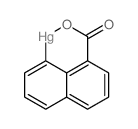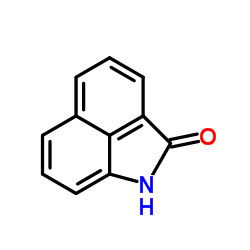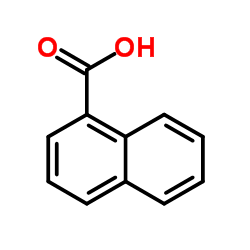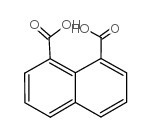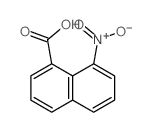8-Bromo-1-naphthoic acid
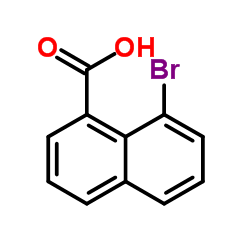
8-Bromo-1-naphthoic acid structure
|
Common Name | 8-Bromo-1-naphthoic acid | ||
|---|---|---|---|---|
| CAS Number | 1729-99-3 | Molecular Weight | 251.076 | |
| Density | 1.6±0.1 g/cm3 | Boiling Point | 421.2±18.0 °C at 760 mmHg | |
| Molecular Formula | C11H7BrO2 | Melting Point | 169-171ºC | |
| MSDS | N/A | Flash Point | 208.5±21.2 °C | |
| Name | 8-Bromo-1-naphthoic acid |
|---|---|
| Synonym | More Synonyms |
| Density | 1.6±0.1 g/cm3 |
|---|---|
| Boiling Point | 421.2±18.0 °C at 760 mmHg |
| Melting Point | 169-171ºC |
| Molecular Formula | C11H7BrO2 |
| Molecular Weight | 251.076 |
| Flash Point | 208.5±21.2 °C |
| Exact Mass | 249.962936 |
| PSA | 37.30000 |
| LogP | 3.90 |
| Vapour Pressure | 0.0±1.1 mmHg at 25°C |
| Index of Refraction | 1.698 |
| InChIKey | DMEZDDHJCUHENA-UHFFFAOYSA-N |
| SMILES | O=C(O)c1cccc2cccc(Br)c12 |
Synonym: Section 2 - COMPOSITION, INFORMATION ON INGREDIENTS
Risk Phrases: None Listed. Section 3 - HAZARDS IDENTIFICATION EMERGENCY OVERVIEW
Not available. Potential Health Effects Eye: May cause eye irritation. Skin: May cause skin irritation. May be harmful if absorbed through the skin. Ingestion: May cause irritation of the digestive tract. May be harmful if swallowed. Inhalation: May cause respiratory tract irritation. May be harmful if inhaled. Chronic: Not available. Section 4 - FIRST AID MEASURES Eyes: Flush eyes with plenty of water for at least 15 minutes, occasionally lifting the upper and lower eyelids. Get medical aid. Skin: Get medical aid. Flush skin with plenty of water for at least 15 minutes while removing contaminated clothing and shoes. Ingestion: Get medical aid. Wash mouth out with water. Inhalation: Remove from exposure and move to fresh air immediately. Notes to Physician: Treat symptomatically and supportively. Section 5 - FIRE FIGHTING MEASURES General Information: As in any fire, wear a self-contained breathing apparatus in pressure-demand, MSHA/NIOSH (approved or equivalent), and full protective gear. Extinguishing Media: Use water spray, dry chemical, carbon dioxide, or chemical foam. Section 6 - ACCIDENTAL RELEASE MEASURES General Information: Use proper personal protective equipment as indicated in Section 8. Spills/Leaks: Vacuum or sweep up material and place into a suitable disposal container. Section 7 - HANDLING and STORAGE Handling: Avoid breathing dust, vapor, mist, or gas. Avoid contact with skin and eyes. Storage: Store in a cool, dry place. Store in a tightly closed container. Section 8 - EXPOSURE CONTROLS, PERSONAL PROTECTION Engineering Controls: Use adequate ventilation to keep airborne concentrations low. Exposure Limits CAS# 1729-99-3: Personal Protective Equipment Eyes: Not available. Skin: Wear appropriate protective gloves to prevent skin exposure. Clothing: Wear appropriate protective clothing to prevent skin exposure. Respirators: Follow the OSHA respirator regulations found in 29 CFR 1910.134 or European Standard EN 149. Use a NIOSH/MSHA or European Standard EN 149 approved respirator if exposure limits are exceeded or if irritation or other symptoms are experienced. Section 9 - PHYSICAL AND CHEMICAL PROPERTIES Physical State: Solid Color: white Odor: Not available. pH: Not available. Vapor Pressure: Not available. Viscosity: Not available. Boiling Point: Not available. Freezing/Melting Point: 162 - 164 deg C Autoignition Temperature: Not available. Flash Point: Not available. Explosion Limits, lower: Not available. Explosion Limits, upper: Not available. Decomposition Temperature: Solubility in water: Specific Gravity/Density: Molecular Formula: C11H7BrO2 Molecular Weight: 251 Section 10 - STABILITY AND REACTIVITY Chemical Stability: Not available. Conditions to Avoid: Incompatible materials. Incompatibilities with Other Materials: Oxidizing agents. Hazardous Decomposition Products: Carbon monoxide, carbon dioxide, hydrogen bromide, bromine. Hazardous Polymerization: Has not been reported Section 11 - TOXICOLOGICAL INFORMATION RTECS#: CAS# 1729-99-3 unlisted. LD50/LC50: Not available. Carcinogenicity: 8-Bromo-1-naphthoic acid - Not listed by ACGIH, IARC, or NTP. Section 12 - ECOLOGICAL INFORMATION Section 13 - DISPOSAL CONSIDERATIONS Dispose of in a manner consistent with federal, state, and local regulations. Section 14 - TRANSPORT INFORMATION IATA No information available. IMO No information available. RID/ADR No information available. Section 15 - REGULATORY INFORMATION European/International Regulations European Labeling in Accordance with EC Directives Hazard Symbols: Not available. Risk Phrases: Safety Phrases: S 24/25 Avoid contact with skin and eyes. WGK (Water Danger/Protection) CAS# 1729-99-3: No information available. Canada None of the chemicals in this product are listed on the DSL/NDSL list. CAS# 1729-99-3 is not listed on Canada's Ingredient Disclosure List. US FEDERAL TSCA CAS# 1729-99-3 is not listed on the TSCA inventory. It is for research and development use only. SECTION 16 - ADDITIONAL INFORMATION N/A |
| Hazard Codes | Xi: Irritant; |
|---|---|
| Risk Phrases | 36/37/38 |
| Safety Phrases | S24/25 |
| HS Code | 2916399090 |
|
~83% 
8-Bromo-1-napht... CAS#:1729-99-3 |
| Literature: Wiley, Jenny L.; Smith, Valerie J.; Chen, Jianhong; Martin, Billy R.; Huffman, John W. Bioorganic and Medicinal Chemistry, 2012 , vol. 20, # 6 p. 2067 - 2081 |
|
~% 
8-Bromo-1-napht... CAS#:1729-99-3 |
| Literature: Organic Letters, , vol. 10, # 20 p. 4425 - 4428 |
|
~% 
8-Bromo-1-napht... CAS#:1729-99-3 |
| Literature: Journal of the American Chemical Society, , vol. 105, # 19 p. 6096 - 6103 |
|
~% 
8-Bromo-1-napht... CAS#:1729-99-3 |
| Literature: Journal of the Chemical Society, Perkin Transactions 2: Physical Organic Chemistry (1972-1999), , p. 2049 - 2050 |
|
~% 
8-Bromo-1-napht... CAS#:1729-99-3 |
| Literature: Journal of the Chemical Society, , p. 175,177 |
| HS Code | 2916399090 |
|---|---|
| Summary | 2916399090 other aromatic monocarboxylic acids, their anhydrides, halides, peroxides, peroxyacids and their derivatives VAT:17.0% Tax rebate rate:9.0% Supervision conditions:none MFN tariff:6.5% General tariff:30.0% |
| 8-Bromo-1-naphthoic acid |
| 8-bromonaphthalene-1-carboxylic acid |
| 1-Naphthalenecarboxylic acid, 8-bromo- |
| MFCD00029357 |
| EINECS 217-045-9 |
